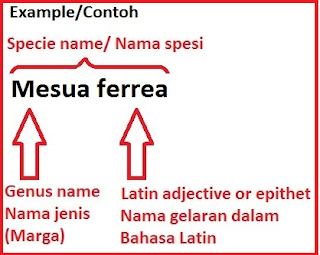Begitulah bunyi soalan yang saya biasa dapat dari kawan kawan. Jawapan nya ialah kita kena belajar dengan buku atau pun internet dan bertanya kepada orang yang tahu selain dari melihat sendiri secara fizikal (bentuk dan rupa daun, batang dan sebagainya) terhadap pokok pokok yang diminati.
KENAPA MUSTAHAK TAHU NAMA SAINS POKOK?
Nama biasa atau nama tempatan tidak berapa tepat, mengelirukan dan pada kebiasaannya satu nama merakumi banyak jenis pokok manakala nama sains pula adalah tepat kepada spesi yang dinamakan dan semua orang didunia mengunakan nama yang sama. Nama biasa juga berubah mengikut loghat tempatan dan nama pula berbeza mengikut tempat. Macamana pun nama tempatan juga penting oleh kerana nama tempatan digunakan apabila mencari pokok pokok dikampong kampong, Boleh mendapat matlumat yang lebih mendalam. Memang kita mendapat matlumat dari internet hanya dengan menaip nama tempatan tetapi dengan menaip nama sains kita boleh mendapat matlumat dari setiap perusuk dunia.
MENCARI NAMA SAINS POKOK
Scientific names comprise of two names (Binomials)
LATIN ADJECTIVE OR EPITHET (SPECIFIC NAME)/ NAMA GELARAN DALAM
BAHASA LATIN
Latin adjective or epithet (specific name)specifically describe the plants and the following criteria are use:-
Named after the native country or location where the plant was first found
Livistona chinensis: Chinensis means China
Ravenala madagascariensis; Madagscariensis means Madagascar.
Mangifera indica; indica means India
Among the well known plants that are only found at certain location in Malaysia are Serdang Endau, Livistona Endauensis (found only at Taman Negara Endau Rompin, Johor) ;Palas Bintulu , Licuala bintuluensis (found only at Bintulu Sarawak): Daun Payung Perak - Johannesteijsmannia perakensis ( Found at Hilly area near Ipoh about few hudred meters from a housing estate. I had visited all the above 3 sites and quite worried about the one near Ipoh as 4WD vehicle tracks can be seen entering the area and there are sign that some plants has been dug out.
Named after the person who found the plant
Acriopsis ridleyi, Lecanortchis ridleyana or Dendrobium ridleyanum are all named after H.N Ridley. British Botanist that introduce Rubber to Malaysia
Named according to the character of the plant
Such as creeping, climbing, conical, shape and colour of leaves or flowers, sizes of the plants etc
When you study the scientific name or Botanical name of plants an d you know a bit of Latin, you will realised that the given name has actually already describe and narrow down to specific plants and the following are few examples:-
Pisonia alba: Alba in Latin means white, and in this case referring to foliage colour, the colour to other plants can be referring tocolour of the flower or other components of the plants.
Asplenium nidus: Nidus referrind to the shape of the plant that look like a nest.
The following are some meaning translation from the given Latin name that can describe the whole plants, the leaves, flowers, bark etc:
Pisonia alba: Alba in Latin means white, and in this case referring to foliage colour, the colour to other plants can be referring tocolour of the flower or other components of the plants.
Asplenium nidus: Nidus referrind to the shape of the plant that look like a nest.
The following are some meaning translation from the given Latin name that can describe the whole plants, the leaves, flowers, bark etc:
Rubra - Red
Purpurata/ purpurea - Purple
Gigantea - large or big size
Elatior - Taller
Fragrans - Pleasant smell
Foetida - stinking smell
Grandiflora - Bearing large leaves
Aurea - golden

No comments:
Post a Comment